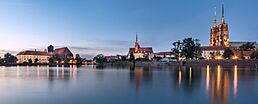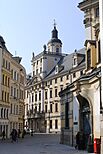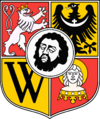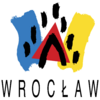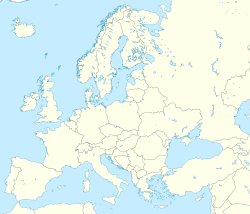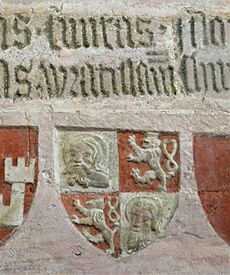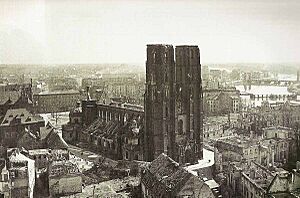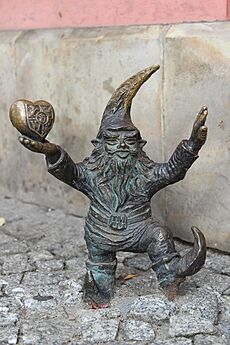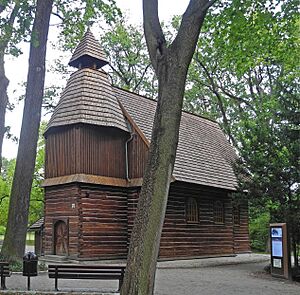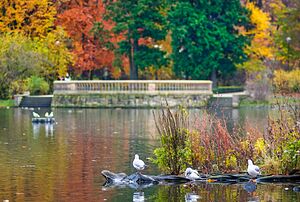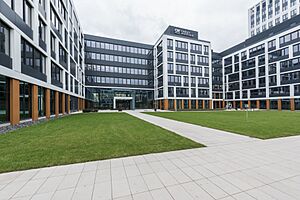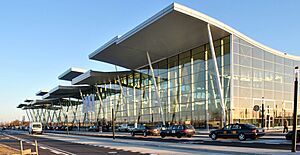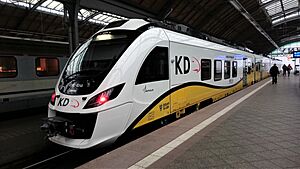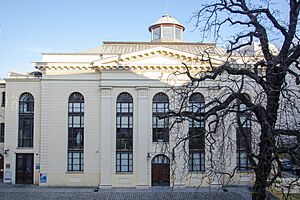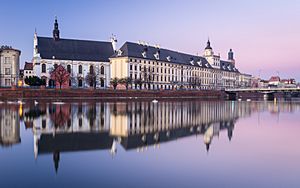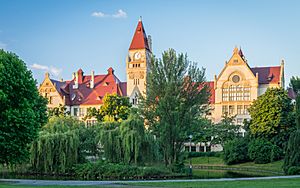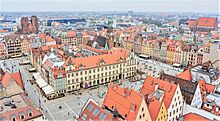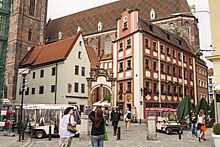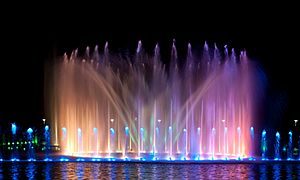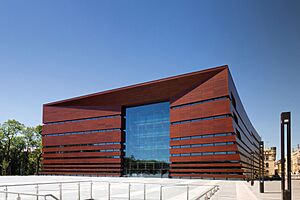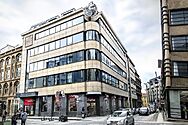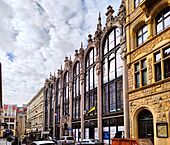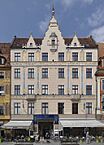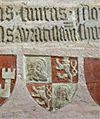Wrocław facts for kids
Quick facts for kids
Wrocław
|
|||||
|---|---|---|---|---|---|
|
Cathedral Island with Wrocław Cathedral
Market Square
Wrocław Town Hall
Puppet Theatre
Monopol Hotel
Wrocław Główny station
|
|||||
|
|||||
| Motto(s): | |||||
| Country | |||||
| Voivodeship | |||||
| County | city county | ||||
| Established | 10th century | ||||
| City rights | 1214 | ||||
| Government | |||||
| • Body | Wrocław City Council | ||||
| Area | |||||
| • City | 292.81 km2 (113.05 sq mi) | ||||
| • Metro | 3,627 km2 (1,400 sq mi) | ||||
| Highest elevation | 155 m (509 ft) | ||||
| Lowest elevation | 105 m (344 ft) | ||||
| Population
(30 June 2023)
|
|||||
| • City | 674,132 (3rd) | ||||
| • Density | 2,302/km2 (5,960/sq mi) | ||||
| • Metro | 1,250,000 | ||||
| • Metro density | 344.6/km2 (893/sq mi) | ||||
| • Demonym |
|
||||
| GDP | |||||
| • Metro | €15.222 billion (2020) | ||||
| Time zone | UTC+1 (CET) | ||||
| • Summer (DST) | UTC+2 (CEST) | ||||
| Postal code |
50-041 to 54–612
|
||||
| Area code(s) | +48 71 | ||||
| Car plates | DW, DX | ||||
| Primary airport | Wrocław Airport | ||||
Wrocław is a big city in southwestern Poland. It is the largest city in the historical region of Silesia. The city sits on the Oder River in the Silesian Lowlands. It is about 40 kilometers from the Sudeten Mountains. As of 2023, Wrocław has 674,132 people. This makes it the third largest city in Poland. The wider area around Wrocław has about 1.25 million people.
Wrocław is the historical capital of Silesia and Lower Silesia. Today, it is the capital of the Lower Silesian Voivodeship. The city's history goes back over 1,000 years. It has been part of many different countries. These include the Kingdom of Poland, Kingdom of Bohemia, Kingdom of Hungary, Habsburg monarchy of Austria, Kingdom of Prussia, and Germany. It became part of Poland again in 1945 after World War II.
Wrocław is a university city. Over 130,000 students live here. This makes it one of the most youth-focused cities in Poland. The University of Wrocław has had nine Nobel Prize laureates. It is known for its great teaching. Wrocław also has many old landmarks. These include the Main Market Square, Cathedral Island, Wrocław Opera, National Museum, and the Centennial Hall. The Centennial Hall is a UNESCO World Heritage Site. The city is also home to the Wrocław Zoo, which is the oldest zoo in Poland.
Wrocław is seen as a "Sufficiency global city" by the GaWC. It is often called one of the best places to live. In 2021, it was ranked first among medium and small cities by fDi Intelligence. Wrocław has hosted many big events. These include the European Youth Meetings of the Taizé Community (1989, 1995, 2019). It also hosted the Eucharistic Congress in 1997 and the 2012 European Football Championship. In 2016, Wrocław was a European Capital of Culture and the World Book Capital. That same year, it hosted the Theatre Olympics and World Bridge Games. In 2017, the city hosted the World Games. In 2019, UNESCO named it a City of Literature.
Contents
Exploring the History of Wrocław
The name of the city, Wrocław, comes from the Polish name Wrocisław. This name is similar to the Czech name Vratislav. The German name for the city, Breslau, also came from this old Slavic name.
Early Beginnings of Wrocław
In ancient times, a place called Budorigum was near Wrocław. People lived in this area from the 6th century. A West Slavic tribe called the Ślężans built a fortified village on Ostrów Tumski. Wrocław started where two important trade routes met. These were the Via Regia and the Amber Road. Archeologists believe the city was founded around 940. In 985, Duke Mieszko I of Poland took control of Silesia. He built new defenses on Ostrów Tumski. The city was first mentioned in writing in 1000 AD. It became an important church center during the Congress of Gniezno.
Wrocław in the Middle Ages
In its early days, Wrocław was controlled by different groups. These included the Duchy of Bohemia and the Kingdom of Poland. The Piast dynasty then ruled the Duchy of Silesia. A very important event was the start of the Diocese of Wrocław in 1000. This made Wrocław a key religious center in Poland.
The city grew into a busy trading hub. It spread to Wyspa Piasek (Sand Island) and then to the left bank of the River Oder. Around 1000, about 1,000 people lived there. In 1109, Polish Prince Bolesław III Wrymouth won a battle against the German King Henry V. This stopped the German army from moving into Poland. Old Polish writings from the 12th century called Wrocław one of the three main cities of the Polish Kingdom.
Wrocław became a place where different cultures met. It had Polish, Czech, German, and Jewish communities. In the 13th century, Wrocław was a political center for the divided Polish kingdom. In 1241, during the first Mongol invasion of Poland, people left the city. It was burned down to stop the Mongols. But Henry II the Pious successfully defended Wrocław Castle.
After the Mongol invasion, more German settlers came to Wrocław. They slowly became the main group of people. But the city kept its mix of cultures. This was because it was an important trading spot. In 1242, the city started using German town law. The city council used both Latin and German. The German name Breslau began to appear in records. Polish was used less and less. In 1261, the city got Magdeburg rights. This gave the city council more power to rule itself. Two Polish kings, Henry II the Pious and Henryk IV Probus, were buried in Wrocław churches.

In 1335, Wrocław became part of the Duchy of Bohemia. In 1348, it officially joined the Holy Roman Empire. The city joined the Hanseatic League in 1387. This was a group of trading cities. In 1443, a big earthquake hit the city. It damaged many buildings.
Between 1469 and 1490, Wrocław was part of the Kingdom of Hungary. In 1474, the city left the Hanseatic League. That same year, Polish and Czech armies tried to take the city. But a peace agreement was signed. Wrocław stayed under Hungarian rule. In 1475, the first book printed in Polish was made in Wrocław.
Changes and New Ideas
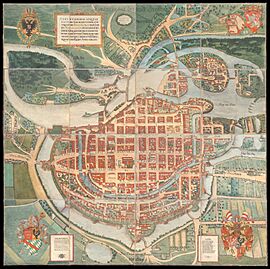
In the 16th century, the Protestant Reformation came to Wrocław. The city became Protestant. But from 1526, the Catholic House of Habsburg ruled Silesia. During the Thirty Years' War, the city was taken by Saxon and Swedish troops. Many people died from the plague.
The Emperor brought in the Counter-Reformation. This meant more Catholic groups came to the city. They built many buildings that changed the city's look. Wrocław was one of the few Silesian cities that stayed Protestant after the war.
In the 18th century, Wrocław became a center for German literature. In 1742, the Kingdom of Prussia took control of the city and most of Silesia. This happened during the War of the Austrian Succession. Austria tried to get Silesia back during the Seven Years' War but failed.
Modern Times in Wrocław
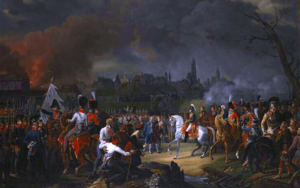
During the Napoleonic Wars, French armies occupied Wrocław. The city's defenses were torn down. Monasteries were taken over. In 1811, a university from Frankfurt was moved to Wrocław. It joined with the local Jesuit University. This created the new Silesian Frederick-William University. The city became a center for Germans fighting against Napoleon.
After the wars, Wrocław grew. It became an important railway and industrial center. The university became a major science hub. In 1871, Wrocław became the sixth-largest city in the German Empire. Its population grew very fast. By 1910, over half a million people lived there.
In 1890, work began on the Breslau Fortress. Important landmarks opened in 1910. These included the Kaiser bridge (now Grunwald Bridge) and the Technical University. The Centennial Hall was built in 1913. It is now a World Heritage Site.
During World War I, the city was a center for German war efforts. After the war, Wrocław became the capital of the new Prussian Province of Lower Silesia. In the 1920s, the city's borders expanded. Its population reached 600,000. In 1929, the WuWa exhibition showed modern architecture.
Before World War II, Wrocław was a large city in Germany. It became a strong base for the Nazi Party. When Adolf Hitler came to power in 1933, political enemies were treated badly. One of the first concentration camps was set up in the city. In 1938, the Nazi police destroyed the Polish cultural center. Many people were sent to concentration camps.
Wrocław in World War II
During the invasion of Poland in 1939, Germans arrested Polish activists. Wrocław became a base for groups that persecuted Poles. For most of the war, the city was safe from fighting. But in 1945, Wrocław became a battlefield. It was the site of a harsh Siege of Breslau. Adolf Hitler said the city must be held at all costs. An evacuation in January 1945 led to 18,000 people freezing to death.
In February 1945, the Soviet Army attacked the city. Half of Wrocław was destroyed by the end of the three-month siege. Wrocław was the last major German city to surrender. This happened just two days before the end of the war in Europe. Up to 80,000 civilians died.
After the war, the Potsdam Conference decided that Wrocław would become part of Poland. The Polish name Wrocław became official.
Wrocław After 1945
The German people who lived in Wrocław were moved out between 1945 and 1949. They went to other parts of Germany. The city's population grew with Poles who moved from areas Poland lost to the Soviet Union. Many came from cities like Lviv and Vilnius.
In 1963, Wrocław was closed off because of a smallpox outbreak. In the 1980s, during martial law in Poland, groups like Fighting Solidarity and Orange Alternative started in Wrocław. The famous Wrocław's dwarves statues came from the Orange Alternative movement.
Pope John Paul II visited the city in 1983 and 1997. In 1997, a huge flood, called the Millennium Flood, hit the city. About one-third of Wrocław was flooded. The city has since worked to prevent future floods.
In 2016, Wrocław was named the European Capital of Culture. In 2017, it hosted the 2017 World Games. Wrocław won the European Best Destination title in 2018. Today, Wrocław is a unique European city. Its buildings show Polish, Czech, Austrian, and Prussian styles.
Geography and Nature
Wrocław is located in the Silesian Lowlands. It sits on the Oder River and its four smaller rivers: Bystrzyca, Oława, Ślęza, and Widawa.
Plants and Animals in Wrocław
Wrocław has 44 city parks and green spaces. They cover about 800 hectares. Some famous parks are Szczytnicki Park, Park Południowy (South Park), and Anders Park. The Botanical Garden was founded in 1811. It has an Alpine garden and a lake.
Over 200 types of birds have been seen in Wrocław. More than 100 of these birds nest here. Common birds include pigeons, sparrows, rooks, and magpies. You can also see swifts, kestrels, and mute swans.
Because of nearby wooded areas, you might see hedgehogs, foxes, wild boar, and squirrels. Other animals include deer, beavers, and badgers. Sometimes, escaped muskrats and raccoons are seen.
Wrocław's Climate
Wrocław has a mild climate. Winters are usually not too cold and dry. Summers are warm and sunny. Most rain falls during summer thunderstorms. Wrocław is one of the warmest cities in Poland. The average yearly temperature is 9.7°C. The highest temperature ever recorded was 38.9°C. The lowest was -32°C.
Wrocław's Economy
Wrocław is the second richest large city in Poland, after Warsaw. It has many leasing and banking companies. Because it is close to Germany and the Czech Republic, Wrocław trades a lot with these countries.
Wrocław is a very innovative city. It has many research and development (R&D) centers. Businesses and universities work together here. Many high-tech companies are in Wrocław. These include Siemens, Bosch, Whirlpool Corporation, Nokia Networks, Volvo, HP, IBM, and Google. Wrocław also has large Polish companies like Getin Holding and AmRest.
The city has a growing high-tech sector. Many tech companies are in the Wrocław Technology Park. Large companies like LG and Toshiba have factories nearby. Wrocław is also a big center for the pharmaceutical industry.
Wrocław has Poland's largest shopping mall, Aleja Bielany. It is located in Bielany Wrocławskie.
Getting Around Wrocław
Wrocław is a major transport hub. It connects Western and Central Europe with other parts of Poland. The A4 highway runs south of the city. It links Wrocław to other Polish cities and to Germany and Ukraine. The A8 bypass goes around the city. It connects to major roads leading to Poznań, Warsaw, and Prague.
Traffic can be a problem in Wrocław. It is the fifth most congested city in Poland. Finding parking can also be hard.
Flying to Wrocław
The city has the Wrocław Airport. It is about 10 kilometers southwest of the city center. Many airlines fly here, including LOT Polish Airlines, Ryanair, and Wizz Air. In 2019, over 3.5 million passengers used the airport. This makes it the fifth busiest airport in Poland.
Trains and Buses in Wrocław
The main train station is Wrocław Główny. It is the busiest train station in Poland. You can take direct trains to many Polish cities. There are also direct trains to Berlin and Vienna.
Next to the train station is a central bus station. It is in the basement of the Wroclavia shopping mall. Many bus companies offer services from here.
Public Transport in Wrocław
Wrocław has a good public transport system. It has 99 bus lines and 23 tram lines. The Municipal Transport Company MPK runs them. You can buy tickets at bus stops or on the vehicle. Tickets can be for one ride or for a certain amount of time. Many buses and trams are low-floor, making them easy to use.
There are also many taxi companies. You can use apps like Uber and Bolt.
Other Ways to Get Around
Wrocław has 1200 km of cycling paths. The City Bike rental network has 2000 bicycles. You can rent regular bikes, tandem bikes, and electric bikes.
You can also rent electric motorized scooters using mobile apps. Car rental systems like Traficar are available too. A gondola lift called Polinka crosses the Oder River. Wrocław also has a river port and several marinas.
People and Culture
Population of Wrocław
In December 2020, Wrocław had 641,928 people. The population has been growing since 2011. The city's population is getting older. More seniors live here now.
Historically, Wrocław's population grew fast in the 19th and 20th centuries. By 1933, it had 625,000 people. Many people moved to the city from other regions.
After World War II, many German residents left. Poles from other parts of Poland moved in. Today, Wrocław has many people from other countries. Most are workers from Ukraine. Others come from Italy, Spain, South Korea, and India. Many foreign students also study in Wrocław.
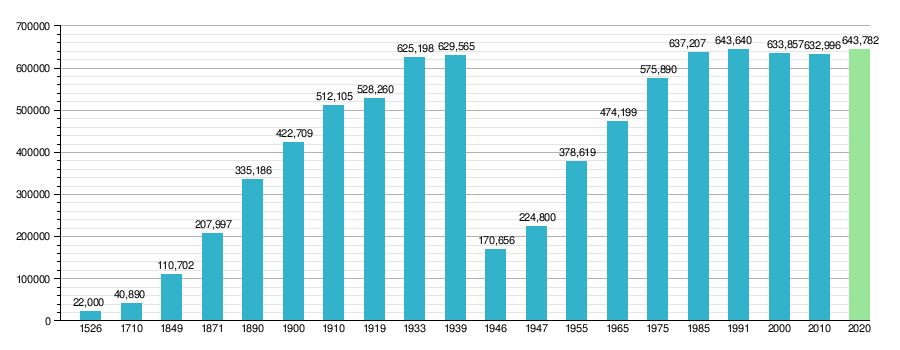
Religions in Wrocław
Most people in Wrocław are Roman Catholic, like in the rest of Poland. The first church area (diocese) was set up here in 1000. Before World War II, many Protestants lived in Wrocław. There were also many Catholics and a large Jewish community.
Wrocław is special because of its "Borough of Four Temples." This area in the Old Town has a synagogue, a Lutheran church, a Roman Catholic church, and an Eastern Orthodox church all near each other.
Learning and Education in Wrocław
Wrocław is Poland's third largest education center. It has 135,000 students in 30 colleges. About 7,400 staff work there.
The city has many public universities:
- University of Wrocław: Over 47,000 students.
- Wrocław University of Technology: Over 40,000 students.
- Wrocław Medical University
- Wrocław University of Economics
- Wrocław University of Environmental and Life Sciences
- Academy of Fine Arts in Wrocław
- Karol Lipiński University of Music
There are also private universities and cultural institutions. These include the British Council and the Grotowski Institute in Wrocław.
Fun Places and Landmarks in Wrocław
Exploring Wrocław's Old Town
Wrocław's Old Town is a protected historical area. It has beautiful buildings in Brick Gothic and Baroque styles. You can also see Neoclassicism and Modernism. Famous buildings include the Wrocław Opera House, Monopol Hotel, and the National Museum.
Ostrów Tumski (Cathedral Island) is the oldest part of the city. It used to be an island. The Wrocław Cathedral is here. It is one of the tallest churches in Poland. The island also has other churches and old buildings. A special thing to see are the 102 gas lanterns. A lamplighter lights them by hand every evening.
The Main Market Square (Rynek) is from the early 13th century. It is one of the largest medieval squares in Poland. It has the beautiful Gothic Old Town Hall. In the northwest corner is St. Elisabeth's Church. It has a tall tower with a viewing deck. Next to the church are two small houses called "Jaś i Małgosia." They are named after Hansel and Gretel.
Top Tourist Spots in Wrocław
Wrocław is a popular place for tourists. You can find free Wi-Fi in many places.
Some cool places to visit are:
- The Multimedia Fountain
- Szczytnicki Park with its Japanese Garden
- The Botanical Garden
- Poland's largest railway model, Kolejkowo
- Hydropolis Centre for Ecological Education
- The University of Wrocław with its Mathematical Tower
- The Royal Palace
- The White Stork Synagogue
- The Old Jewish Cemetery
A fun way to explore is to find Wrocław's dwarfs. There are over 800 small bronze statues hidden around the city. They first appeared in 2005.

The Racławice Panorama is a huge painting. It shows the Battle of Racławice from 1794. It is 15 by 114 meters!
Wrocław Zoo has the Africarium. This is a special area just for animals from Africa. It is the oldest zoo in Poland, started in 1865. It also has the third-largest number of animal species in the world.
You can take boat tours on the Oder River. Old trams and buses also offer city tours. The Centennial Hall is a World Heritage Site.
Museums to Visit
The National Museum has one of the biggest collections of modern art in Poland.
Ossolineum is a national library and institute. It has important historical items.
Other museums include:
- The City Museum of Wrocław
- Museum of Architecture
- Museum of Natural History at University of Wrocław
- Museum of Pharmacy
- Post and Telecommunications Museum
Fun and Entertainment
Wrocław is known for its many nightclubs and pubs. Many are near the Market Square. The basement of the old City Hall has Piwnica Świdnicka. This is one of the oldest restaurants in Europe, open since 1273.
Every year in November and December, a Christmas market is held at the Main Market Square.
Films, Music, and Theatre
Many famous Polish films and TV shows have been made in Wrocław. Directors like Andrzej Wajda started their careers here. Movies like Bridge of Spies were filmed in the city.
Wrocław has several theaters. The Polish Theatre has three stages. The International Theatre Festival Dialog-Wrocław happens every two years.
The Wrocław Opera has a long history, going back to the 17th century. The National Forum of Music opened in 2015. It is a famous building for music lovers.
Sports in Wrocław
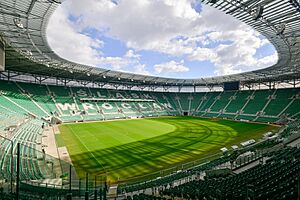
Wrocław has many popular professional sports teams. The most popular sport is football. The Śląsk Wrocław club has won the Polish Championship twice. Basketball is also popular. The Śląsk Wrocław Basketball Club has won the Polish Championship 17 times.

Wrocław hosted matches for UEFA Euro 2012. It also hosted EuroBasket 1963 and EuroBasket 2009. In 2017, Wrocław hosted the World Games. This event features 37 non-Olympic sports.
The Olympic Stadium hosts the Speedway Grand Prix of Poland. It is home to the motorcycle speedway club WTS Sparta Wrocław. They have won the Polish Championship five times.
A marathon takes place in Wrocław every September.
Men's Sports Teams
- Śląsk Wrocław: Football team.
- WTS Sparta Wrocław: Motorcycle speedway team.
- Śląsk Wrocław: Basketball team.
- Śląsk Wrocław: Handball team.
- Gwardia Wrocław: Volleyball team.
- Panthers Wrocław: American football team.
Women's Sports Teams
- Ślęza Wrocław: Basketball team.
- WKS Śląsk Wrocław: Football team.
Famous People from Wrocław
- Alois Alzheimer, a doctor who studied the brain
- Max Born, a physicist and Nobel Prize winner
- Dietrich Bonhoeffer, a theologian who spoke out against the Nazis
- Fritz Haber, a chemist and Nobel Prize winner
- Mirosław Hermaszewski, an astronaut
- Hubert Hurkacz, a tennis player
- Olga Tokarczuk, a writer and Nobel Prize winner
- Jan Tomaszewski, a famous footballer
- Wanda Rutkiewicz, a mountaineer
Wrocław's Global Connections
Wrocław has many international connections. It has two general consulates for Germany and Ukraine. It also has 23 honorary consulates for other countries.
Sister Cities
Wrocław is twinned with many cities around the world:
 Batumi, Georgia (2019)
Batumi, Georgia (2019) Breda, Netherlands (1991)
Breda, Netherlands (1991) Charlotte, United States (1991)
Charlotte, United States (1991) Cheongju, South Korea (2023)
Cheongju, South Korea (2023) Dresden, Germany (1991)
Dresden, Germany (1991) Guadalajara, Mexico (1995)
Guadalajara, Mexico (1995) Hradec Králové, Czech Republic (2003)
Hradec Králové, Czech Republic (2003) Kaunas, Lithuania (2003)
Kaunas, Lithuania (2003) Lille, France (2013)
Lille, France (2013) Lviv, Ukraine (2002)
Lviv, Ukraine (2002) Oxford, United Kingdom (2018)
Oxford, United Kingdom (2018) Ramat Gan, Israel (1997)
Ramat Gan, Israel (1997) Reykjavík, Iceland (2017)
Reykjavík, Iceland (2017) Vienne, France (1990)
Vienne, France (1990)
 Wiesbaden, Germany (1987)
Wiesbaden, Germany (1987)
Images for kids
-
The oldest printed text in the Polish language–Statuta Synodalia Episcoporum Wratislaviensis, printed in Wrocław by Kasper Elyan, 1475
-
Map of the city from 1562, with its fortifications on the Oder River
-
Battle of Breslau during the Seven Years' War (Third Silesian War 1756–1763)
See also
 In Spanish: Breslavia para niños
In Spanish: Breslavia para niños


